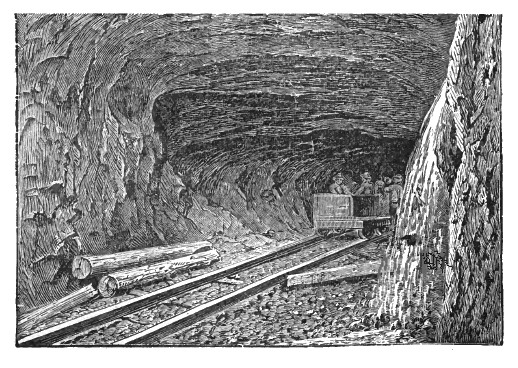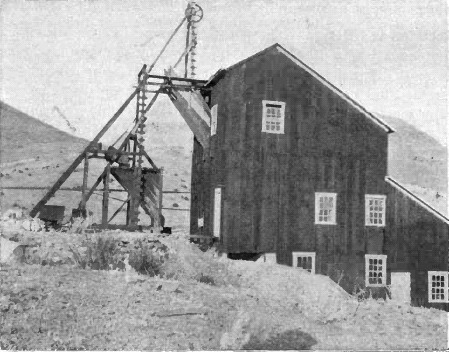In West Australia tellurides are being mined in three localities Redhill, Bardoc, Kalgoorlie and the wonderful development of the last has given a new impulse to the whole industry of the colony. Thus, one hears much of Cripple Creek, and, lately, of Kalgoorlie. In both districts very rich lodes, characterized by telluride ores, have been opened up, with results so eloquent as to silence the story of the more numerous localities where these particular minerals have been only a metallurgical obstacle associated with ore bodies of no satisfactory continuity. As a consequence, investors are prepared to swallow the rhetorical confectionery of an irresponsible press, and to believe that a new era has dawned for any neglected region in which these tellurides are now for the first time recognized. Believe me; the compounds of tellurium are far more widely dispersed in gold ores than is generally supposed.
I have detected them in several mines when a low extraction in the stamp mill suggested an unusual difficulty in the ore, and it is certain that during the next few years the greater familiarity with these minerals will lead to their recognition in so many unsuspected localities, that they will cease to be a mineralogical curiosity. The sulphide ore of Mount Morgan, Queensland, carries tellurides. The fact was determined early on by Mr. E. S. Simpson, Government Assayer for West Australia. How much of the early trouble in the treatment of the oxidized ores is explained by this discovery? It also recalls to me the resemblance between the dull brown gold of some of the Mount Morgan ore and that of the first discoveries at Cripple Creek in 1892.
The idea, now very prevalent, that at Kalgoorlie especially the presence of calaverite and sylvanite tellurides guarantees persistent richness is contradicted by several facts, the most notorious of which should be the fact that the very mine in which they were first recognized (by Mr. J. C. Moulden, in May, 1896), and subsequently acclaimed by the local press as heralding sure prosperity, has proved unprofitable; indeed, the particular ore-body in which the first telluride was seen has been demonstrated by later development to be an isolated patch leading to nothing of any moment. Moreover, the lodes at Kalgoorlie vary in the amount of tellurides which they carry without any proportionate difference in their richness. The gold occurs not only in chemical combination with tellurium, but also in its ordinary native condition. Further, tellurides occur which do not contain gold. The so-called “black tellurium" of certain mines is the rare telluride of mercury, called "coloradoite," from the locality of its first discovery. Native tellurium also exists. Again, some of the veins even below the zone of oxidation are so free from tellurium as not to differ from ordinary gold bearing reefs. Yet there is no reason to suppose that these are less rich or less persistent than those which are characterized by a notable percentage of tellurides.
It is not too much to say, therefore, that the observations gathered from the working of telluride ores in various parts of the world refute the idea that their occurrence has any particular bearing on the question of persistence in depth; while, on the other hand, experience has frequently demonstrated that their presence is an important and objectionable factor from a metallurgical standpoint, because it increases the cost of gold extraction. Thus we are brought to face the general question of the enrichment of gold ores in depth. It is, however, outside the scope of this contribution. As a far-reaching fallacy, persisting in spite of the accumulated experience of many mining regions, it possesses a pestilent vitality, which must at times astonish those who from the actual direction of mining operations have seen so much evidence to the contrary. I am referring now to gold mines only, because the facts relating to baser metals, which by oxidation become soluble, differ in detail. Gold and tin are in this respect unlike copper ore and silver ores. While, therefore, I do not wish on this occasion to reopen the whole subject, I cannot forbear referring to the question as it has come up for discussion in West Australia, where I have lately been. In that country the assertion is made with tiresome iteration that veins become richer below the water level, because in the oxidized zone the ore has been impoverished by the leaching out of the gold. It is also held by many who pose as having authority and not as the scribes, that if the outcrop give evidence of notable mineralization it is reasonable to expect almost barren quartz to become valuable when the sulphides are reached in the ordinary course of deeper mining. If these pleasant doctrines are questioned, you are bidden to go to Kalgoorlie, where, so they say, you will be forced by the evidence there obtainable to admit the fact that lodes which now attract the attention of the financial world, were too poor to meet expenses until the mine workings penetrated into the unoxidized ore. Indeed, at Kalgoorlie especially this idea has a strong foothold, especially among stockjobbers.
The matter seemed to me to be one of great interest. If the facts really did indicate a general enrichment of the veins as they approached the drainage level of the district, which is also the water level of the mines, then Kalgoorlie offered a striking exception to the experience of other goldfields. If, moreover, a satisfactory theory were forthcoming to account for these unusual facts, then the uncertain chemistry of ore occurrence would receive invaluable aid. But the prettily colored bubble was dissipated as soon as an earnest investigation was commenced. The history of the development of the lodes, and a few quiet conversations with the able men who have come from elsewhere to direct the big mines, were sufficient to stamp this as another resurrection of a fallacy that was old before the Phoenicians came to Cornwall. To say that mines get richer in depth is, in such a region as West Australia, a cruel cynicism. If anyone is inclined to believe it, let him wander over the desert, and count the idle stamp mills which lie rusting in the sweltering sun, and the long succession of abandoned shafts which now serve only to water the passing camel train. By mere repetition of an untruth you may effect persuasion, but you do not alter the falsity of it.
If you omit the manifest failures and turn to the production of the more successful mines in the gold rush districts of Menzies, Murchison, Coolgardie, and Norseman, you will still find that it is a work of supererogation to attempt a serious discussion of the statement that the veins have improved in depth. Incomplete as the Government statistics are, and vitiated by a total lack of system in the determination of the actual tonnage treated at the mills, yet they, too, tender an emphatic denial. The alleged facts are further explained by a general hypothesis that the gold in the oxidized ore has been leached out so that it is beneath its normal richness, which will be found unimpaired below the water level. This is stated to be evidenced by the removal of the iron pyrites, the casts of the crystals of which now appear as cavities in the quartz. In some of these gold is found, but in others it is absent, proving, so it is said, that the gold has been removed from the cavities which are now empty. The occurrence of films of fine gold, called "paint gold," on the faces of fractures is instanced as an illustration of secondary reactions.
Finally, the alkaline composition of the waters in the mines is quoted in proof of their solvent power. Although the chemistry of the oxidized zone is far from being thoroughly understood, yet in its incompleteness it is sufficient to disprove these arguments. When iron pyrites is decomposed the sulphide becomes a sulphate, and this in turn, by further oxidation in the presence of water, is resolved into sulphuric acid and the hydrated oxide of iron. The native sulphur frequently seen in the cavities left by the removal of the cubes of pyrites is not a direct product of decomposition, but is traceable to later secondary reactions in which the organic matter of the surface has served as a reducing agent. The gold intimately mixed with the pyrites, and probably originally deposited with it, remains, because the noble metal is insoluble to the waters which dissolved the iron.
The occurrence of gold in pyrites is now less of a mystery than it used to be. Microscopic examination has disclosed the existence of the gold in the planes of the pyrites, and the leaching of the gold by cyanide solutions without any apparent deformation of the pyrites is no less suggestive. It is indeed true that in some of the casts, left by the removal of the sulphides gold does not occur, but this is frequently due to the fact that it is very difficult to break a piece of cellular quartz without shaking the gold out of the cavities in which it lies loosely. Hence their emptiness may mean nothing. At other times this may indeed be due to the real absence of the gold, and against this observation we then balance another, namely, that the pyrites as we find it unaltered below the water level also varies in its gold contents, so that in the same vein it is sometimes barren and sometimes rich, accounting in this way for the uncertain presence of free gold in the oxidized zone. The "paint gold," frequently noticed in the gossan, appears to be the result of secondary and comparatively recent reactions. It is, however, only a proof of precipitation, and therefore presupposes a previous leaching, but not necessarily in the vadose region. It evidences local enrichment rather than impoverishment.
Of the solvent power of surface waters upon the gold there is only supposition, and this supposition must first overcome the fact of the occurrence of such organic matter in the ground approaching the surface as would reduce any known salts of gold should they be in solution. In the Sugarloaf Mine, near Kunanalling, I saw the roots of trees at 74 ft., and in the Great Boulder Main Reef Mine, at Kalgoorlie, I saw some which had penetrated the rock to 85 ft. below the surface. In the former case the oxidation of the enclosing rock ceases at 130 ft. and in the latter at 175 ft. The region is an unusually dry one, which has undergone erosion with extreme slowness; and this is doubtless the reason why roots in search of moisture should penetrate so deeply. The waters of the mines are all brackish; they are many times more salt than the sea. Analyses made at the Great Boulder Proprietary Mine show an average in solids of 8'9 per cent., and of this 6.2% was chloride of sodium, 0.45% chloride of magnesia, and 0.73% sulphate of lime. The water from the Lane shaft gave the maximum of 11.9 per cent, solids, containing NaCl (halite), MgCl2, and CaS04(gypsum) .
Continue on To:
Minerals Which
Accompany Gold Ores, Part IV


